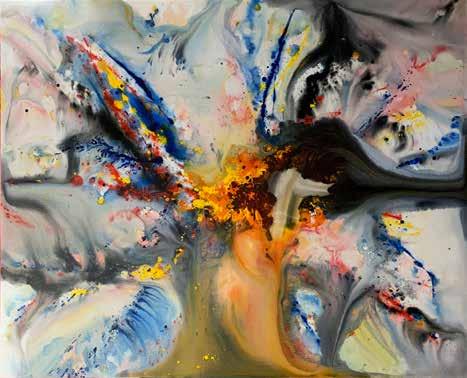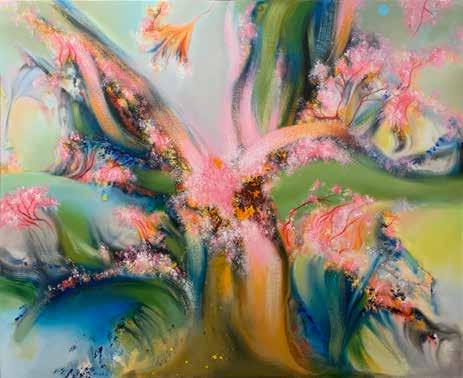
3 minute read
Painting towards an Aesthetic End
from Jolly @ 80
I begin a painting by pouring various acrylic colours onto the canvas. No matter how I may plan the design of the painting, the result of the pouring will be totally unexpected due to the very nature of the pouring method.
I believe that everything in life is a matter of chance and the visual result from my throwing colours on the canvas is just another example of chance. Whatever pattern that is formed on the canvas is totally unpredictable. (See figures 1 and 2 for examples.) Not all of the accidental marks on the canvas are aesthetically good. Thus I have to modify those marks, shapes, etc., until I believe them to be good. The final resulting quality of the painting is, of course, a reflection of my own aesthetic sensibility.
Advertisement
All artists, of whatever persuasion, have to deal with the sensory marks that they have put onto their canvases. Dealing with the marks entail deciding whether, say, the reds are in the right places or the shapes are too big or too small – in short they have to organise the visual data into some sort of an arrangement. The final organisation of the sensory structure is either aesthetically good, bad or indifferent. The final or finished results also reflects on the sensibility of the artists.
I work for long hours, weeks and months on a painting until every tone, colour and shape all form together into one organic whole that I consider to be beautiful. In the beautiful words of T.S. Eliot, apropos, a good poem,
“ … And every phrase And sentence that is right (where every word is at home, Taking its place to support the others, ….. The complete consort dancing together)”
The final result of my struggle with the sensory structure of my painting reveals the quality of my aesthetic sensibility. (See pg 43 for the final result of figure 1, and figure 2.)
Thus the final result is the manifestation, for better or worse, of my aesthetic sensibility. Thus, also, the quality of the painting (the sensory structure) is a manifestation of my aesthetic sensibility.
The inevitable question is, what makes for an aesthetically good sensory structure? My answer, in this context, is to look and analyse the many canonical paintings in the National Gallery in London, especially those of the 15th to the 18th century. All those paintings are of high aesthetic quality which is why some of them are regarded as masterpieces. In the words of E. H. Gombrich, “It is a great work of art not because it has so many meanings, but because it is beautiful.” And those paintings in the National Gallery in London are beautiful because their sensory structures are beautiful. It is an enduring indictment on art educators and art critics that so little analysis of the sensory structures of those masterpieces have been done.
Instead of talking or writing about the sensory qualities that contribute to the beauty of paintings, art critics talk or write endlessly of their narrative contents or the narratives associated with the paintings. A recent example of such an anti-aesthetic stance towards paintings can be seen in the recent BBC TV series Art of America by Andrew Graham-Dixon.
Dr. Jolly Koh June 2021
Figure 1: Seven Sisters at the acrylic stage The final result of Seven Sisters (page 131) after modifications with oils


Figure 2: Sakura at the acrylic stage The final result of Sakura (page 159) after modifications with oils







